Spine Engine Swing Lateral Bend
April 2010
- by Kelvin Miyahira
Correspondences with Dr. Serge Gracovetsky have allowed me an opportunity to take a closer look at the spine engine and how it works in greater depth. Although I have written a more detailed background informational paper on the spine engine theory as applied to great golf swings, I would rather explain how these moves work in golf terms for the general golfing population at this point (if anyone needs this detailed explanation, please email me directly at This email address is being protected from spambots. You need JavaScript enabled to view it.). And rather than make the case for its existence, I'd rather everyone assume it exists (though maybe only in the best swings) and show you how it applies to the golf swing in traditional golf terms. For this month, I will cover the lateral bend in the spine engine golf swing and detail the lumbar lordosis for next month as we continue down this path.
According to Dr. Gracovetsky and the research on spine movements, lateral bending plus lumbar lordosis will produce axial rotation. This is due to the fact that our vertebrae have facets that are like geared teeth. See pictures below from Gracovetsky's book.
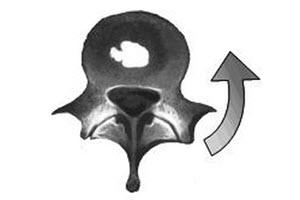

And when these facets connect to each other, they act like gears and produce rotation. But they can only do that when the two moves; lateral bend and lumbar lordosis are paired together. Thus, these two major moves are of utmost importance if we are to use our spine engine. If not, you're only left with muscular effort to overcome the lack of assistance from the powerful spine engine.
In the end, the ultimate goal is to use both spine engine and muscular effort to produce the most powerful and repeatable swing. The problem is that if the spine engine isn't working, it leads to swing dysfunctions and worse yet, back injury. So let's take a closer look at these moves in golf terms.
Lateral Bend
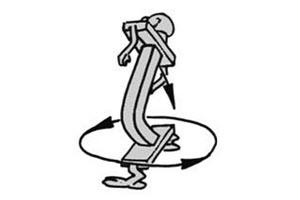
Lateral bend, although it seems simple, is really quite complicated. Simplistically, it is just a side bending like the picture above. But add in that this must be done at a while you're at the top of your backswing with shoulders turned, while in the absence of downswing shoulder rotation (if for a brief moment), while your spine is being bent to the right, your shoulder is pulled down behind you while increasing lumbar lordosis (explained later) and while the rotator cuff muscles are externally rotating the arm. Now this seems very complicated.
So when does lateral bending occur? It should start during transition. If you try to do it later, it just won't have the time to bend as it should and over the top shoulder moves will result. Also, the lateral bend needs to keep increasing and retained past impact before letting up.
Overview of Lateral Bend
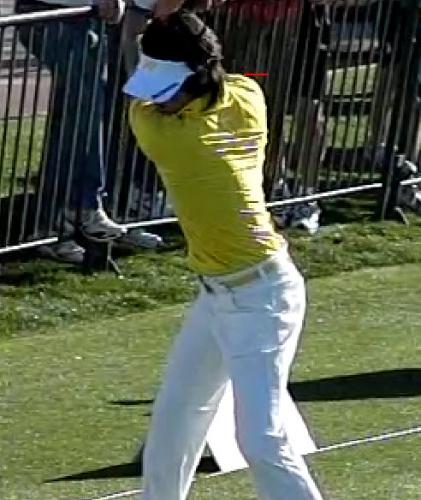
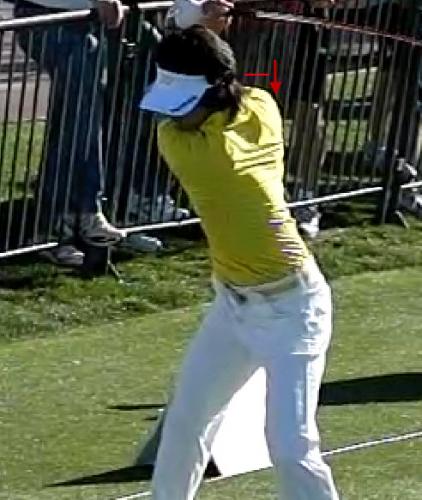
Here's young Ryo Ishikawa showing his lateral bend. I've drawn a red line where his shoulder is at the top of the backswing. Then notice in the second picture how his right shoulder has dropped.
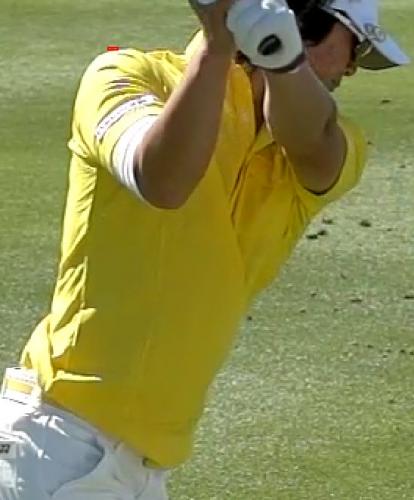
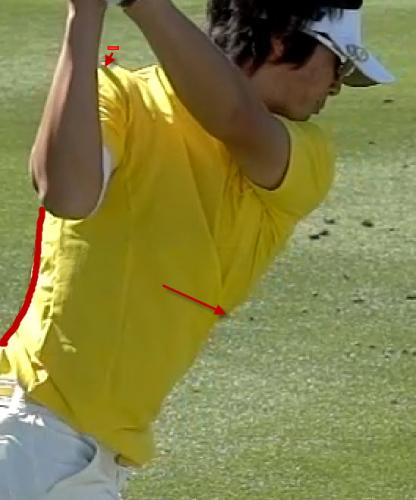
From this view, we can see that his shoulder has dropped AND his right side is arching away from the ball. If you'll look very closely at the left side of his body in the second picture, you'll see a slight outward protrusion of his left side/rib cage area outwards to the ball.
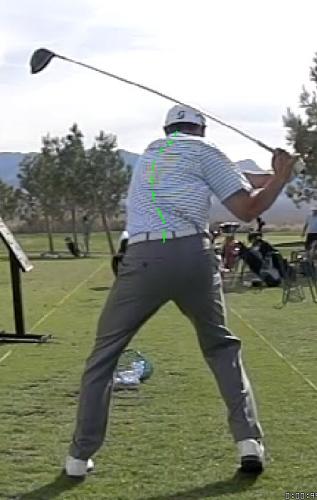
A little later in the downswing, one can see Jamie Sadlowski's lateral bending. It looks sort of like a reverse-imaged question mark.
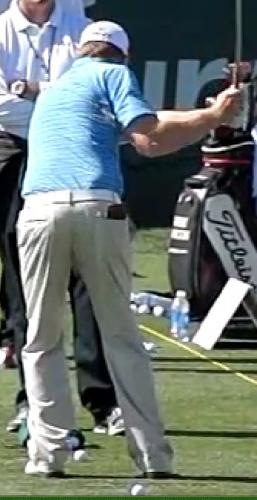
Here's Hunter Mahan with a similar curve in his spine.
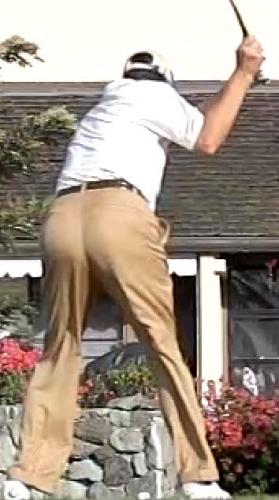
As a contrast, if one's spine is looking more like a straight line that's just tilted to the right, there isn't much lateral bend in the spine as you can see above. This is more of a move of the hip with the entire spine tilted right. This is totally not the lateral bend that Dr. Gracovetsky is talking about.
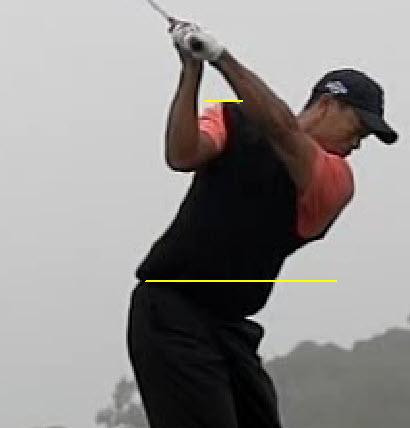
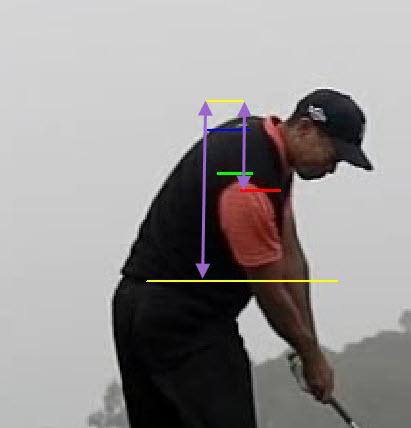
Tiger's swing shows just how much lower his right shoulder is at impact vs. the top of his backswing. The distance between his right shoulder and right hip has decreased by at least half.
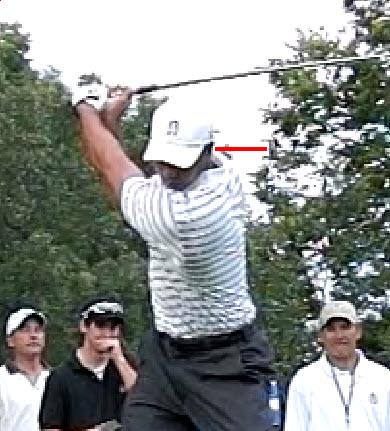
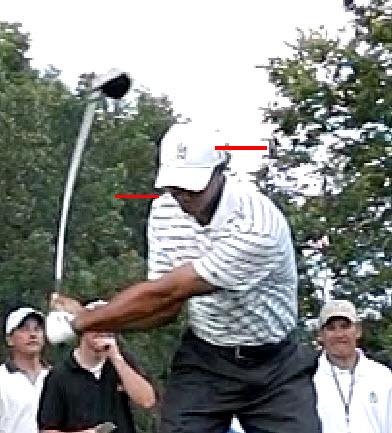
From front view, notice how much Tiger's right shoulder has dropped when moving from the top of his backswing to where his shoulder is visible on the right side of his head. Though part of this drop is due to his entire body dropping, this does show some of the lateral bending that is occurring. Golfers without this drop in the right shoulder at these two points will have a poor over the top swing.
The other very common possibility is that a planeologist has determined that a golfer with this motion is too steep and will move his/her arm and club flatter on the downswing. What does this mean? Planeology teaches to get the club on plane. Forget what the body is doing to create the poor plane. Just fix the plane, right? Well, this is the true reason people get stuck. Perhaps we shall cover this in more detail in another article.
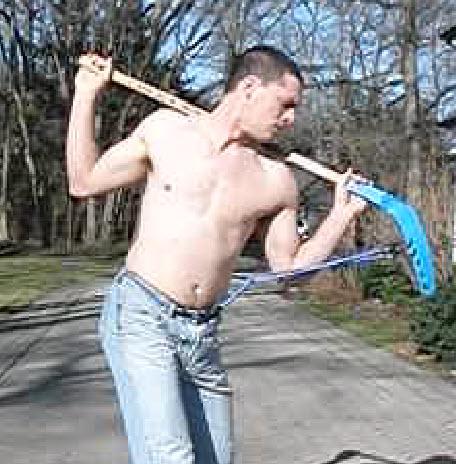
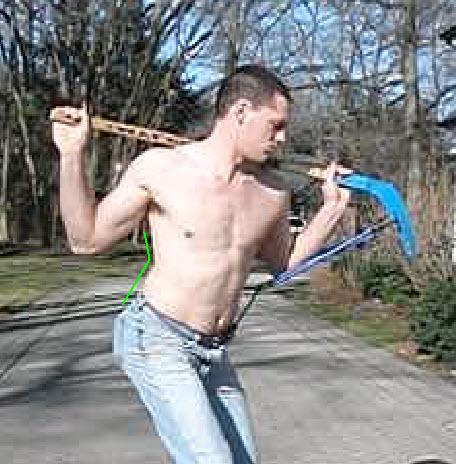
Once again an important point must be made; the shoulder can drop vertically by the entire spine dropping and bending at the hip (incorrect) or by allowing the hips to move toward the ball causing the entire spine to tilt back. Instead, the spine should bend in the middle as Mark is showing here.
Next, let's take a closer look at the micro moves and key muscle groups that make up the lateral bend.
Shoulder Drop in Absence of Shoulder Rotation
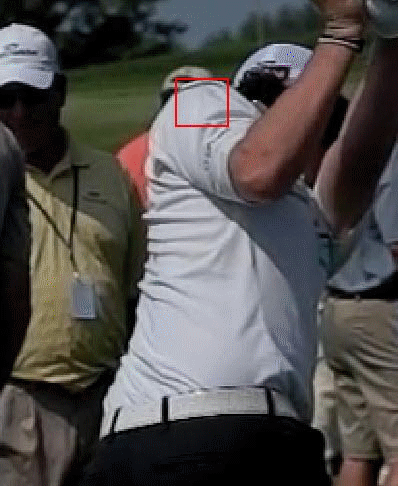
Here's an animation of Rory's right shoulder moving down in transition. This was shot at 300 frames per second and but I'm showing it as 150 frames per second so as to cut down on the amount of stills needed.
Approximately 24 frames of 300 fps video or .08 seconds worth of lateral bending occurs without any shoulder rotation at this point.
This gives the spine facets some time to connect before any rotation begins. If you jump the gun and begin rotating too early, it's harder to get the lateral bend. Thus, without half of the spine engine equation, you'll be left with just muscular effort to produce the needed swing motion.
Right Shoulder Retraction and Scapula Dig
There is something else occurring at the same time the shoulder is dropping. The shoulder is also retracting or the scapula is being pulled towards the spine by the rhomboideus major, minor, and trapezius.
But what is ultra critical here is that along with the lats, these muscles are stretching the pectorals and serratus anterior in preparation for their fire later in the downswing.
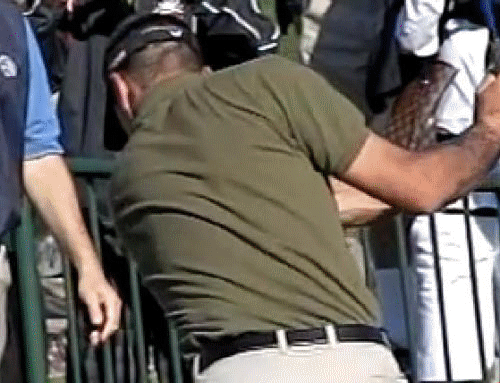
After the retraction, the scapula dig move occurs and is perhaps the glue that holds everything together. The scapula dig is where the scapula is pulled deep in towards the chest cavity. This holds the lateral bend and helps the lats and rotator cuff muscles pull the arm/elbow forward so it does not get stuck behind.
Sometimes, there are multiple events that must take place in order to activate, stretch and then contract certain muscle groups. This is one of them. In order for the rhomboids to work properly, they must be activated by the movements of the backswing and typically accomplished by the lift of the arms (Quiros or Tiger '08 style) or by keep one's width at the top of the backswing (Rickie Fowler style).
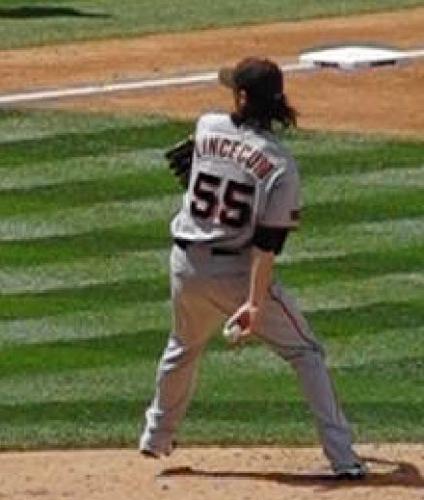
Take a look at the great Tim Lincecum's pitching positions. As he winds up, his arm is low and you can see the scapula slightly retracted in this picture. It's right where the "u" in his name is sewn.
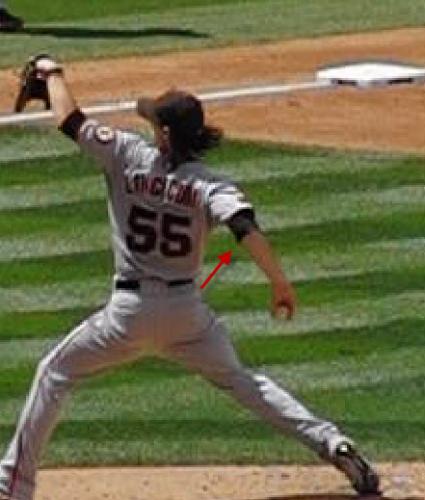
This picture shows the lifting of his arm/elbow to get into position as he continues to retract his shoulder.
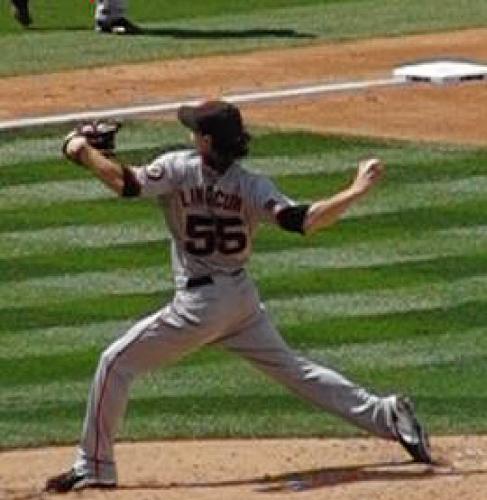
This picture shows the scapula digging with his chest and serratus stretched fully just before the acceleration phase. Notice the "E" in his name is totally hidden.
Golf instructors like to use the analogy of throwing a ball at the ground to illustrate the golf swing's release. Problem is they throw with their arms. If you're going to use a throwing action, wouldn't you want to throw like Tim Lincecum who uses his whole body?
Muscles involved in the Lateral Bend
Right Latissimus Pull
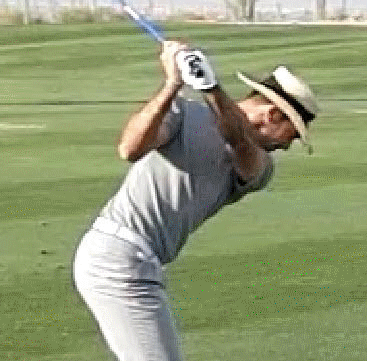
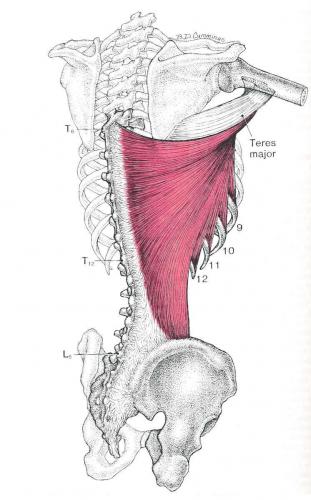
Sorry that these pictures highlight the left latissimus dorsi instead of the right . These muscles exist on both sides of the body. One of the key muscles for laterally bending one's spine is the right latissimus dorsi (LD). It is the widest and most powerful muscle of your back. With connections to the humerus (arm bone), thoracic spinous processes (middle of your back), the iliac crest (largest of pelvic bones), and if we remember contralateral connections to the left glute muscle, the LD is undoubtedly the most important muscle for lateral bending.
The contraction of the LD draws the upper arm downward and forward (elbow move) as well as aids in pulling the shoulder down. The LD is important as well in later stages of the downswing for internal rotation of the shoulder which is another very powerful move.
But perhaps most importantly, the LD is connected to the spinous process which possess the facets or the gears that enable the spine engine to work.
Right Quadratus Lumborum Pull
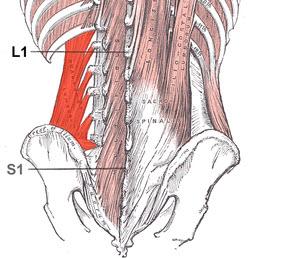
The Quadratus Lumborum (as pointed out by Tom Bielek) is a deeper muscle that is capable of pulling the ribs down to the hips since it its origins is in the pelvic bone and is inserted in the lumbar spinous processes and 12th rib.
Along with the latissimus dorsi that pulls the thoracic spine, the quadratis lumborum pulls the ribs into the lumbar spine and this serves to engage the spine engine.
Rotator cuff muscles
Also involved in throwing and a golf swing, the muscles of the rotator cuff (infraspinatus and teres minor) and the rear deltoid are on the posterior side of the shoulder and are involved in pulling the shoulder back or held in retraction. In addition, this muscle group is directly responsible for the elbow move and external rotation of the shoulder which is another micro move discussed in a previous article.
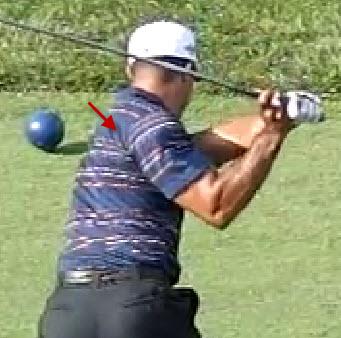
Notice the small creases on the back of his shoulder. That shows the contraction of the muscles on the back of his shoulder.
Obviously there are many more muscles are involved in the lateral bending, but these are the key ones. Leaving any one of these muscles out of your golf swing will produce some type of swing error since the non-use will force other muscle groups to overwork.
Swing Dysfunctions
In my March 2010 article, I discussed the leg driven vs. the spine driven swing and the differences there. But here's the real root of that problem. The leg drive causes an inability to lateral bend and this in turn causes many problems that we recognize such as casting, over the top, hip thrusting, hip stalling and more.
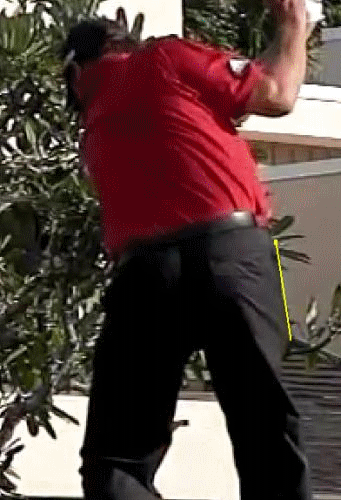
So let's take a look at the not-so-perfect swing of a PGA tour player (unknown) that played in the Sony Open Satellite pro-am tournament (held at a different site than Waialae golf course and is usually reserved for the lower ranked pros). What we see in this pro is the leg driven swing. His legs and not his tailbone or spine engine start the transition/downswing since there's not much of a transition here.
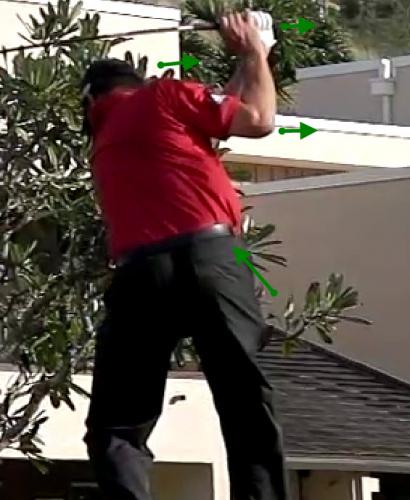
With his legs driving up and forward, there's little chance he can get any lateral bending. There is no room for any drop of the shoulder with the leg pushing up and in the way.
Without the drop, rotation of the shoulders begins and you can see the direction of the force generated by the arrows. His right shoulder moves out and away and so do his hands and elbow. This is why casters cannot simply stop casting by thinking "don't cast." There are some powerful moves in this motion........too bad they are misdirected.
Contrast to AK
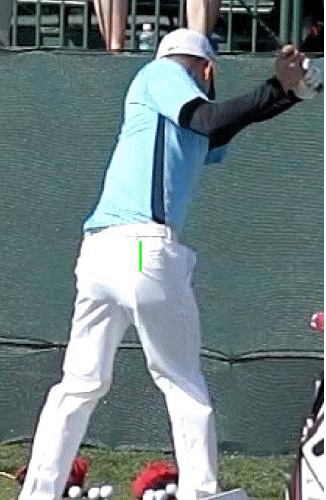

As you can see, the difference between a spine engine driven swing vs. a leg driven swing is huge. By moving his tailbone left and out of the way, Anthony Kim can bend laterally and this creates all the moves we see in great swings.
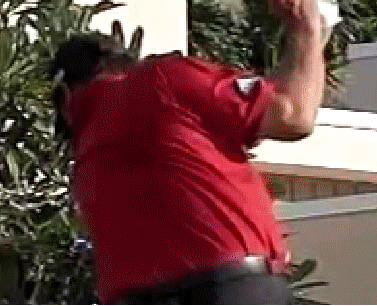
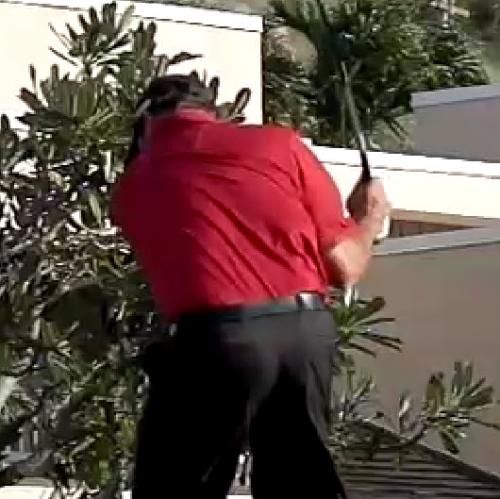
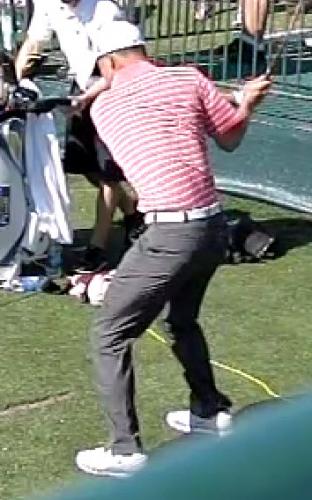
By the start of the downswing, can you see there's not much lateral bend. His spine looks too straight.
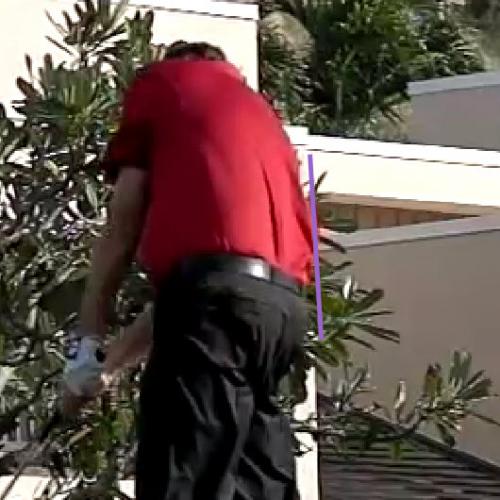
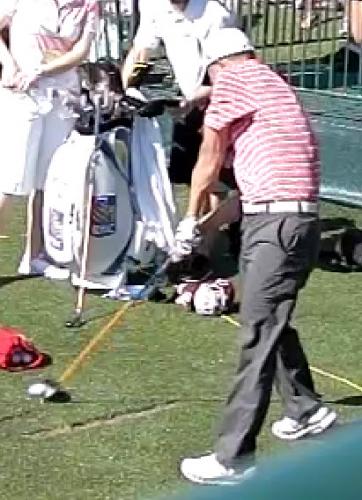
At impact his lower spine is practically vertical and thus, he has no lordosis as well.
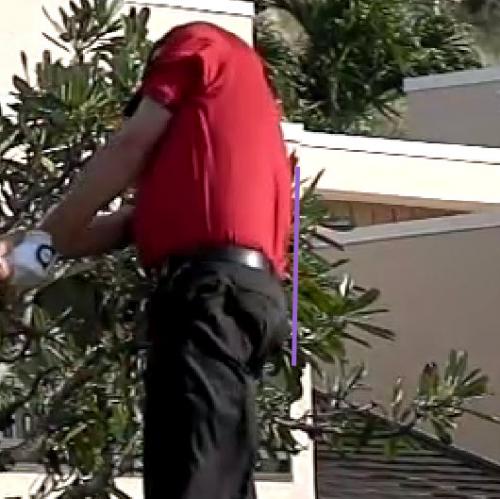
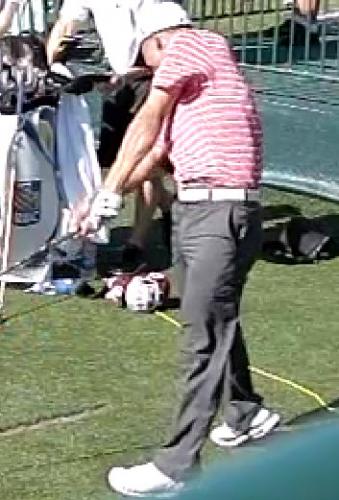
The follow through is just an indication of what occurred before. With the gears unhitched, there's no way he can turn and clear his hips like AK.
As you can see, understanding how your body/spine works is of utmost importance if you want to swing better. By getting the lateral bend in your swing, it will remove your tendencies to cast, swing over the top and get stuck. So if you're struggling with those issues, perhaps it's a good time to take a new look at it instead of your plane. Next month, I'll tackle the 2nd half of the spine engine movements that are critical in engaging your engine.
According to Dr. Gracovetsky and the research on spine movements, lateral bending plus lumbar lordosis will produce axial rotation. This is due to the fact that our vertebrae have facets that are like geared teeth. See pictures below from Gracovetsky's book.


And when these facets connect to each other, they act like gears and produce rotation. But they can only do that when the two moves; lateral bend and lumbar lordosis are paired together. Thus, these two major moves are of utmost importance if we are to use our spine engine. If not, you're only left with muscular effort to overcome the lack of assistance from the powerful spine engine.
In the end, the ultimate goal is to use both spine engine and muscular effort to produce the most powerful and repeatable swing. The problem is that if the spine engine isn't working, it leads to swing dysfunctions and worse yet, back injury. So let's take a closer look at these moves in golf terms.
Lateral Bend

Lateral bend, although it seems simple, is really quite complicated. Simplistically, it is just a side bending like the picture above. But add in that this must be done at a while you're at the top of your backswing with shoulders turned, while in the absence of downswing shoulder rotation (if for a brief moment), while your spine is being bent to the right, your shoulder is pulled down behind you while increasing lumbar lordosis (explained later) and while the rotator cuff muscles are externally rotating the arm. Now this seems very complicated.
So when does lateral bending occur? It should start during transition. If you try to do it later, it just won't have the time to bend as it should and over the top shoulder moves will result. Also, the lateral bend needs to keep increasing and retained past impact before letting up.
Overview of Lateral Bend


Here's young Ryo Ishikawa showing his lateral bend. I've drawn a red line where his shoulder is at the top of the backswing. Then notice in the second picture how his right shoulder has dropped.


From this view, we can see that his shoulder has dropped AND his right side is arching away from the ball. If you'll look very closely at the left side of his body in the second picture, you'll see a slight outward protrusion of his left side/rib cage area outwards to the ball.

A little later in the downswing, one can see Jamie Sadlowski's lateral bending. It looks sort of like a reverse-imaged question mark.

Here's Hunter Mahan with a similar curve in his spine.

As a contrast, if one's spine is looking more like a straight line that's just tilted to the right, there isn't much lateral bend in the spine as you can see above. This is more of a move of the hip with the entire spine tilted right. This is totally not the lateral bend that Dr. Gracovetsky is talking about.


Tiger's swing shows just how much lower his right shoulder is at impact vs. the top of his backswing. The distance between his right shoulder and right hip has decreased by at least half.


From front view, notice how much Tiger's right shoulder has dropped when moving from the top of his backswing to where his shoulder is visible on the right side of his head. Though part of this drop is due to his entire body dropping, this does show some of the lateral bending that is occurring. Golfers without this drop in the right shoulder at these two points will have a poor over the top swing.
The other very common possibility is that a planeologist has determined that a golfer with this motion is too steep and will move his/her arm and club flatter on the downswing. What does this mean? Planeology teaches to get the club on plane. Forget what the body is doing to create the poor plane. Just fix the plane, right? Well, this is the true reason people get stuck. Perhaps we shall cover this in more detail in another article.


Once again an important point must be made; the shoulder can drop vertically by the entire spine dropping and bending at the hip (incorrect) or by allowing the hips to move toward the ball causing the entire spine to tilt back. Instead, the spine should bend in the middle as Mark is showing here.
Next, let's take a closer look at the micro moves and key muscle groups that make up the lateral bend.
Shoulder Drop in Absence of Shoulder Rotation

Here's an animation of Rory's right shoulder moving down in transition. This was shot at 300 frames per second and but I'm showing it as 150 frames per second so as to cut down on the amount of stills needed.
Approximately 24 frames of 300 fps video or .08 seconds worth of lateral bending occurs without any shoulder rotation at this point.
This gives the spine facets some time to connect before any rotation begins. If you jump the gun and begin rotating too early, it's harder to get the lateral bend. Thus, without half of the spine engine equation, you'll be left with just muscular effort to produce the needed swing motion.
Right Shoulder Retraction and Scapula Dig
There is something else occurring at the same time the shoulder is dropping. The shoulder is also retracting or the scapula is being pulled towards the spine by the rhomboideus major, minor, and trapezius.
But what is ultra critical here is that along with the lats, these muscles are stretching the pectorals and serratus anterior in preparation for their fire later in the downswing.

After the retraction, the scapula dig move occurs and is perhaps the glue that holds everything together. The scapula dig is where the scapula is pulled deep in towards the chest cavity. This holds the lateral bend and helps the lats and rotator cuff muscles pull the arm/elbow forward so it does not get stuck behind.
Sometimes, there are multiple events that must take place in order to activate, stretch and then contract certain muscle groups. This is one of them. In order for the rhomboids to work properly, they must be activated by the movements of the backswing and typically accomplished by the lift of the arms (Quiros or Tiger '08 style) or by keep one's width at the top of the backswing (Rickie Fowler style).

Take a look at the great Tim Lincecum's pitching positions. As he winds up, his arm is low and you can see the scapula slightly retracted in this picture. It's right where the "u" in his name is sewn.

This picture shows the lifting of his arm/elbow to get into position as he continues to retract his shoulder.

This picture shows the scapula digging with his chest and serratus stretched fully just before the acceleration phase. Notice the "E" in his name is totally hidden.
Golf instructors like to use the analogy of throwing a ball at the ground to illustrate the golf swing's release. Problem is they throw with their arms. If you're going to use a throwing action, wouldn't you want to throw like Tim Lincecum who uses his whole body?
Muscles involved in the Lateral Bend
Right Latissimus Pull


Sorry that these pictures highlight the left latissimus dorsi instead of the right . These muscles exist on both sides of the body. One of the key muscles for laterally bending one's spine is the right latissimus dorsi (LD). It is the widest and most powerful muscle of your back. With connections to the humerus (arm bone), thoracic spinous processes (middle of your back), the iliac crest (largest of pelvic bones), and if we remember contralateral connections to the left glute muscle, the LD is undoubtedly the most important muscle for lateral bending.
The contraction of the LD draws the upper arm downward and forward (elbow move) as well as aids in pulling the shoulder down. The LD is important as well in later stages of the downswing for internal rotation of the shoulder which is another very powerful move.
But perhaps most importantly, the LD is connected to the spinous process which possess the facets or the gears that enable the spine engine to work.
Right Quadratus Lumborum Pull

The Quadratus Lumborum (as pointed out by Tom Bielek) is a deeper muscle that is capable of pulling the ribs down to the hips since it its origins is in the pelvic bone and is inserted in the lumbar spinous processes and 12th rib.
Along with the latissimus dorsi that pulls the thoracic spine, the quadratis lumborum pulls the ribs into the lumbar spine and this serves to engage the spine engine.
Rotator cuff muscles
Also involved in throwing and a golf swing, the muscles of the rotator cuff (infraspinatus and teres minor) and the rear deltoid are on the posterior side of the shoulder and are involved in pulling the shoulder back or held in retraction. In addition, this muscle group is directly responsible for the elbow move and external rotation of the shoulder which is another micro move discussed in a previous article.

Notice the small creases on the back of his shoulder. That shows the contraction of the muscles on the back of his shoulder.
Obviously there are many more muscles are involved in the lateral bending, but these are the key ones. Leaving any one of these muscles out of your golf swing will produce some type of swing error since the non-use will force other muscle groups to overwork.
Swing Dysfunctions
In my March 2010 article, I discussed the leg driven vs. the spine driven swing and the differences there. But here's the real root of that problem. The leg drive causes an inability to lateral bend and this in turn causes many problems that we recognize such as casting, over the top, hip thrusting, hip stalling and more.

So let's take a look at the not-so-perfect swing of a PGA tour player (unknown) that played in the Sony Open Satellite pro-am tournament (held at a different site than Waialae golf course and is usually reserved for the lower ranked pros). What we see in this pro is the leg driven swing. His legs and not his tailbone or spine engine start the transition/downswing since there's not much of a transition here.

With his legs driving up and forward, there's little chance he can get any lateral bending. There is no room for any drop of the shoulder with the leg pushing up and in the way.
Without the drop, rotation of the shoulders begins and you can see the direction of the force generated by the arrows. His right shoulder moves out and away and so do his hands and elbow. This is why casters cannot simply stop casting by thinking "don't cast." There are some powerful moves in this motion........too bad they are misdirected.
Contrast to AK


As you can see, the difference between a spine engine driven swing vs. a leg driven swing is huge. By moving his tailbone left and out of the way, Anthony Kim can bend laterally and this creates all the moves we see in great swings.



By the start of the downswing, can you see there's not much lateral bend. His spine looks too straight.


At impact his lower spine is practically vertical and thus, he has no lordosis as well.


The follow through is just an indication of what occurred before. With the gears unhitched, there's no way he can turn and clear his hips like AK.
As you can see, understanding how your body/spine works is of utmost importance if you want to swing better. By getting the lateral bend in your swing, it will remove your tendencies to cast, swing over the top and get stuck. So if you're struggling with those issues, perhaps it's a good time to take a new look at it instead of your plane. Next month, I'll tackle the 2nd half of the spine engine movements that are critical in engaging your engine.

